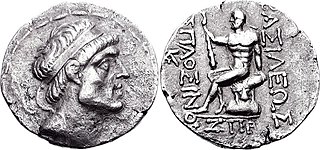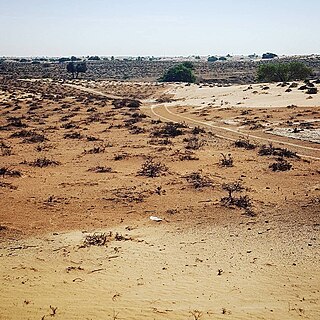
Failaka Island is a Kuwaiti Island in the Persian Gulf. The island is 20 km off the coast of Kuwait City in the Persian Gulf. The name "Failaka" is thought to be derived from the ancient Greek φυλάκιο(ν) – fylakio(n) "outpost".

Characene, also known as Mesene (Μεσσήνη) or Meshan, was a kingdom founded by the Iranian Hyspaosines located at the head of the Persian Gulf. Its capital, Charax Spasinou, was an important port for trade between Mesopotamia and India, and also provided port facilities for the city of Susa further up the Karun River. The kingdom was frequently a vassal of the Parthian Empire. Characene was mainly populated by Arabs, who spoke Aramaic as their cultural language. All rulers of the principality had Iranian names. Members of the Arsacid dynasty also ruled the state.

Nubkheperre Intef was an Egyptian king of the Seventeenth Dynasty of Egypt at Thebes during the Second Intermediate Period, when Egypt was divided by rival dynasties including the Hyksos in Lower Egypt. He is known to be the brother of Sekhemre-Wepmaat Intef—and this king's immediate successor—since he donated Louvre Coffin E3019 for this king's burial which bears an inscription that it was donated for king Sekhemre Wepmaat Intef "as that which his brother, king Antefgives", notes Kim Ryholt. As the German scholar Thomas Schneider writes in the 2006 book Ancient Egyptian Chronology :

Charax Spasinu, also called Charax Spasinou, Charax Pasinu, Spasinu Charax, Alexandria or Antiochia in Susiana, was an ancient port at the head of the Persian Gulf, and the capital of the ancient kingdom of Characene.

Arabian Archaeology and Epigraphy or AAE is a scholarly journal for articles relating to the ancient Arabian Peninsula region.

Shimal is the name of a settlement in Ras Al Khaimah, United Arab Emirates. It is associated with the Shihuh tribe of the Northern UAE and Oman and with the foundation of the Islamic era port of Julfar, and was once the seat of the Ruler of Julfar. It is also the location of an important archaeological site dating back to the Umm Al Nar culture.
Midianite pottery, also known as Qurayya ware is a ware type found in the Hejaz, southern and central Jordan, southern Israel and the Sinai, generally dated to the 13th-12th centuries BCE, although later dates are also possible.

Khanfar is a village that is a southern suburb of Jaʿār in the Abyan Governorate of south-western Yemen. It is said to be inhabited by Yafa peoples.

Hyspaosines was an Iranian prince, and the founder of Characene, a kingdom situated in southern Mesopotamia. He was originally a Seleucid satrap installed by king Antiochus IV Epiphanes, but declared independence in 141 BC after collapse of Seleucid authority in Iran and Babylonia to the Parthians. Hyspaosines briefly occupied the Parthian city of Babylon in 127 BC, where he is recorded in records as king (šarru). In 124 BC, however, he was forced to acknowledge Parthian suzerainty. He died in the same year, and was succeeded by his juvenile son Apodakos.

Tell Abraq(Til Abrook) was an ancient Near Eastern city. Located on the border between Sharjah and Umm Al Quwain in the United Arab Emirates, the city was originally on the coastline of the Persian Gulf but changing sea levels have placed the remains of the city inland. It is located on the main road from Umm Al Quwain to Falaj Al Mualla.
Axidares or Ashkhadar also known as Exedares or Exedates was a Parthian Prince who served as a Roman Client King of Armenia.
Parthamasiris, also known as Partamasir or Parthomasiris was a Parthian Prince who served as a Roman Client King of Armenia.

Theonesios I was a King of Characene, a vassal state of the Parthian empire and important trading port on the Persian Gulf. His rule was from 25/24BC to 19/18BC.

Attambelos II was a king of Characene, a Parthian vassal state and important trading port on the Persian Gulf. His rule was from 17/16 to 9/8BC.

Attambelos III of Characene was a king of Characene who ruled from approximately 37/38 to 44/45AD. His rule is known only by the coins he minted. The presence of these coins as far afield as Oman and southern Arabia indicates that his rule saw a time of extensive trade.

Attambelos IV of Characene was a first century ruler of the state of Characene, centered on the northern end of the Persian Gulf. His capital was probably Charax.

Attambelos V of Characene was a ruler of the state of Characene who ruled from 64/65–73/74 but who is known only from the coins he minted.

Ed Dur, also known as Al Dour and Ad Dour is an Ancient Near Eastern City, today located in Umm Al Quwain, in the United Arab Emirates (UAE). One of the largest archaeological sites in the emirates, comprising an area of some 5 km2 (1.9 sq mi), the coastal settlement overlooks Al Beidha Lake. One of the most important archaeological finds in the UAE, and closely associated with the inland trading centre of Mleiha, Ed Dur has been dubbed 'one of the most significant lost cities of Arabia'.

Theonesios III of Characene was a king of Characene who ruled from approximately 52AD. His rule is known only by the coins he minted.

Wahbarz, known in Greek sources as Oborzos, was a dynast (frataraka) of Persis in the 1st half of 2nd century BC, ruling from possibly c. 205 to 164 BC. His reign was marked by his efforts to establish Persis as a kingdom independent from Seleucid authority. He was able to reign independently for three decades, and even expanded to the west, seizing the Seleucid province of Characene. In 164 BC, the Seleucids repelled Wahbarz's forces from Characene, forcing him to re-submit as a Seleucid vassal. He was succeeded by Baydad.














